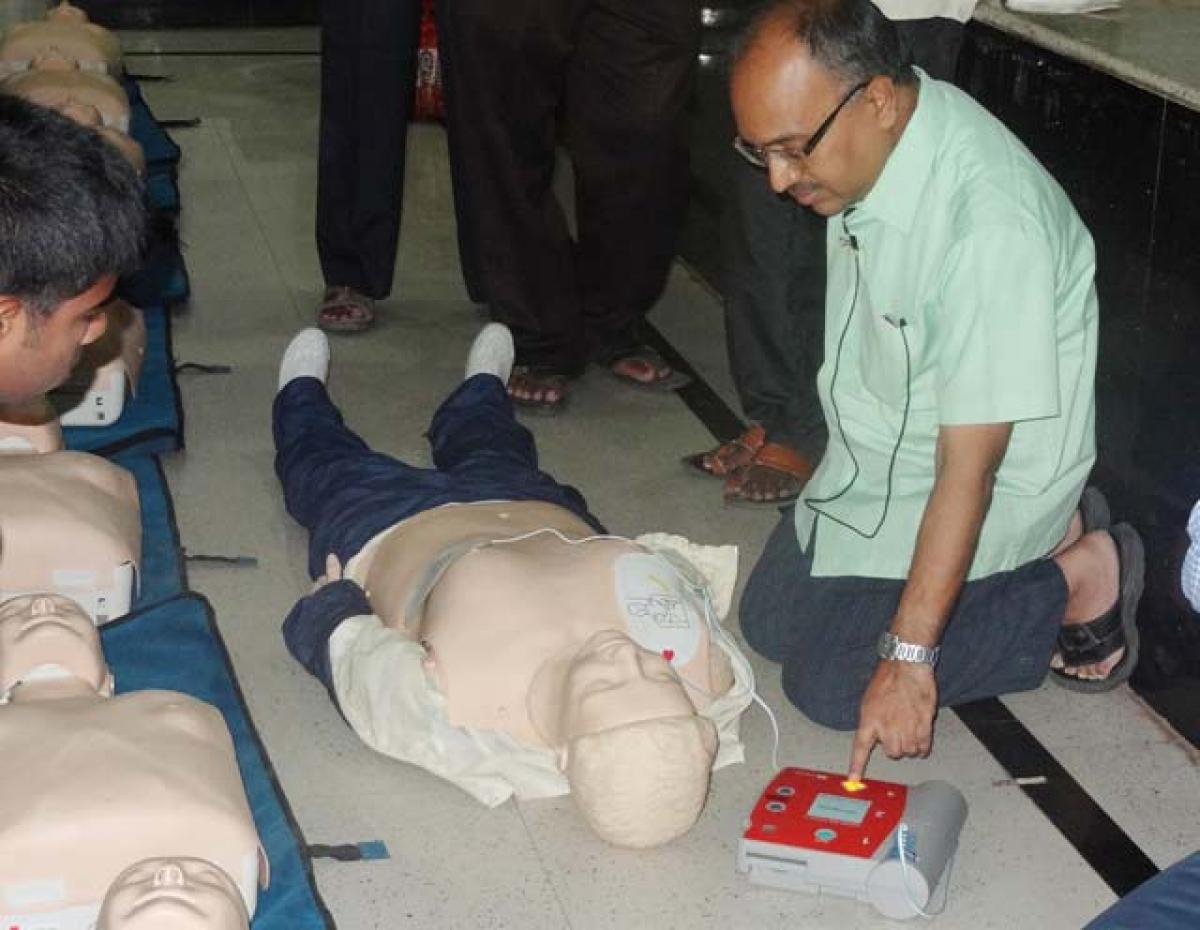Live
- NASA Tracks Five Giant Asteroids on Close Approach to Earth Today
- Pushpa 2 Hits ₹1000 Crore in 6 Days: How It Compares to Other Top Indian Films
- Vivo X200 and X200 Pro Launched in India: Price, Specifications, and Features
- Nitin Gadkari Admits Feeling Embarrassed at Global Summits Over Rising Road Accidents in India
- Comprehensive Review on Indiramma Housing Survey and Welfare Initiatives Conducted via Video Conference
- Jogulamba Temple Records Rs 1.06 Crore Hundi Revenue in 150 Days
- Opposition Slams ‘One Nation, One Election’ Bill as Anti-Democratic; BJP Allies Support the Move
- Celebrate Karthigai Maha Deepam Virtually with Sri Mandir’s LIVE Darshan Experience
- BJP Extends Support to Samagra Shiksha Abhiyan Employees' Strike, Demands Immediate Regularization and Welfare Benefits
- Dr. M. Priyanka Stresses Quality Education, Nutritious Meals, and Cleanliness in Schools
Just In
What to do if someone collapses due to Sudden Cardiac Arrest?


What if someone is collapsing in front of your eyes in a public place due to Sudden Cardiac Arrest (SCA)? This could be a most likely phenomenon that you may encounter at any time in a country where an approximate 4,280 out of every one lakh people die per year with SCA and the response time of emergency medical services is bizarre compared to the international standards of 6 minutes.
Awareness on lifesaving CPR, defibrillator process
Warangal: What if someone is collapsing in front of your eyes in a public place due to Sudden Cardiac Arrest (SCA)? This could be a most likely phenomenon that you may encounter at any time in a country where an approximate 4,280 out of every one lakh people die per year with SCA and the response time of emergency medical services is bizarre compared to the international standards of 6 minutes.
Thanks to the successive governments’ failure to come up with a target-oriented mechanism to create awareness among public about the Hands-Only Cardio-Pulmonary Resuscitation (CPR), a potentially lifesaving technique when someone suddenly collapses due to cardiac emergencies occurring outside medical settings.
According to a report of the Parliamentary Standing Committee on health, only 45 per cent of the funding originally envisaged under the 12th Five Year Plan (2012-2017) has been allocated to the public health. This tells the story of the households how they were pushed into indebtedness and poverty.
While the rulers turning a blind eye in creating awareness about healthcare, especially about the cardiovascular emergencies, among the masses, individuals with social outlook like Dr Ramaka Srinivas, Srinivasa Heart Foundation, Warangal, are voluntarily campaigning for the cause. He has the credit of creating awareness on CPR among thousands of lay public.
He presented a paper - A Study of Adult out of Hospital Cardiac Arrests in an Indian Population - at the World Congress of Cardiology, 2016 at Mexico City held on June 6 as a poster presentation. It was also published in the Global Heart journal. The co-authors are Dr Ravikumar Chodavarapu of Siddhartha Medical College, Vijayawada and Mahesh Machavarapu of Kakatiya Medical College, Warangal.
His study based on the profiles of 123 victims of out of hospital cardiac arrest revealed that they are aged between 40 and 60 and majority of them have at least one of the risk factors - diabetes, hypertension family history, tobacco use and physical inactivity.
Majority of them ignored the symptoms of cardiac arrest and did not go for a cardiac consultation. If they had awareness of cardiovascular symptoms and risk factors, they would have gone for the cardiac checkup which would have prevented the adverse outcome. None of these victims had received CPR.
Speaking to The Hans India, Dr Srinivas said: “There is a need to create awareness about the CPR, besides providing Automated External Defibrillators (AED) in public places like bus stations, railway stations, malls etc. This apart there is a need for providing trained paramedics with the ambulance services and improving the emergency cardiac care in all hospitals.”
The chain of survival includes immediate recognition of cardiac arrest and activation of the emergency response system, followed by early CPR with an emphasis on chest compressions, rapid defibrillation and integrated Post-cardiac arrest care.
How CPR works..
- Begin chest compressions as quickly as possible after a person collapses. Chest compressions consist of forceful rhythmic applications of pressure over the lower half of the lower half of the mid chest using the palms placed one above the other with the fingers entwined, at a speed of 100 to 120 per minute, reaching a depth of 5 to 6 cm. These compressions create blood flow to the brain and vital organs by increasing intra-thoracic pressure and directly compressing the heart.
- The compressions should be followed by 2 rescue breaths (mouth to mouth) sufficient enough to produce a chest rise in the victim.
- Defibrillation Sequence: Turn the Automated External Defibrillator (AED), a device that is used to deliver the shocks, on and follow the machine’s prompts. Resume chest compressions immediately after the shock. This procedure is done till the ambulance service arrives.
May be mentioned here that in our country AED devices are not freely available in public or even most ambulances. With this, more than 99 per cent of Indians face certain death.
By Adepu Mahender

© 2024 Hyderabad Media House Limited/The Hans India. All rights reserved. Powered by hocalwire.com






